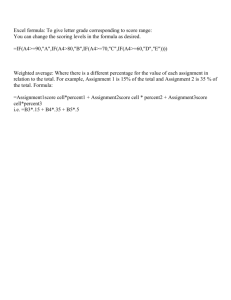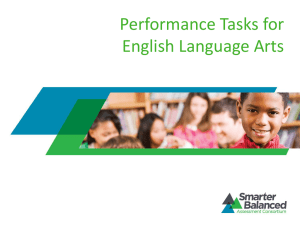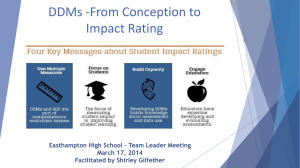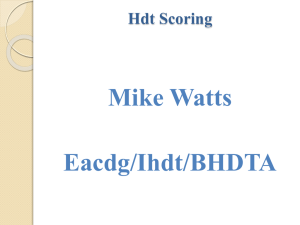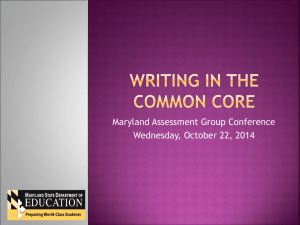Sample 2 - Livonia Public Schools
advertisement
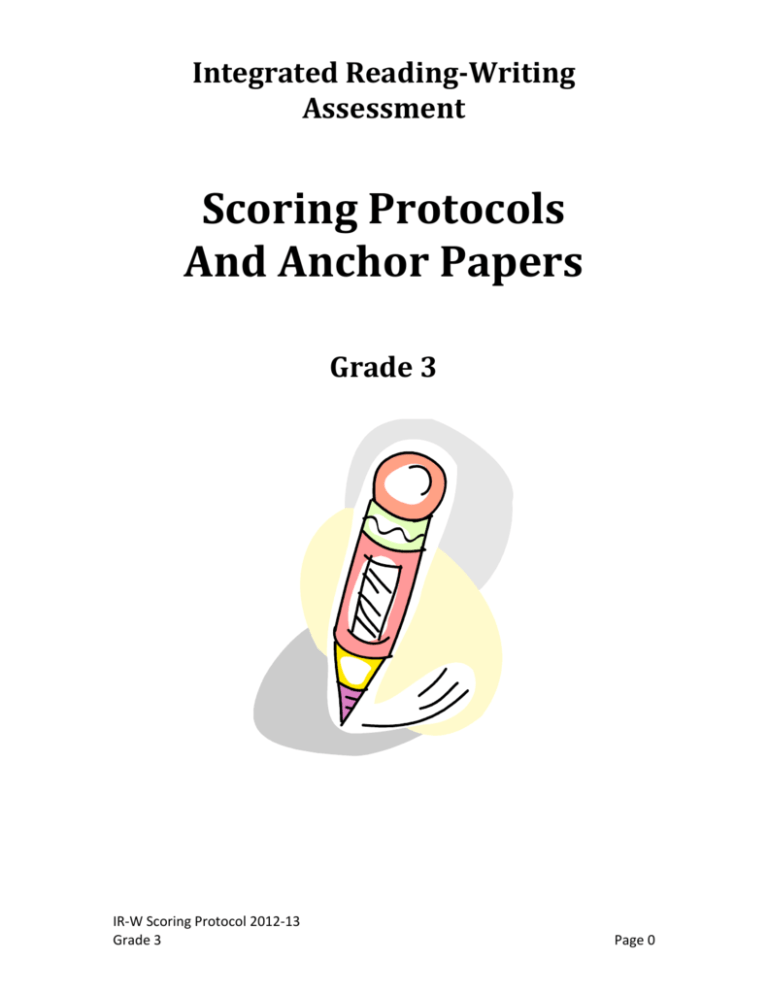
Integrated Reading-Writing Assessment Scoring Protocols And Anchor Papers Grade 3 IR-W Scoring Protocol 2012-13 Grade 3 Page 0 Introduction Each year, students in grades 2-6 are administered the Integrated ReadingWriting Benchmark Assessment (IR-W). The purpose of this assessment is to provide teachers with valuable data that can be used to inform reading and writing instruction. This scoring protocol has been created to implement the use of the new MEAP Analytic Rubric for Narrative Writing. Because we are moving from a holistic rubric to an analytic rubric, we are eliminating the need for each paper to be scored by two readers. In order to establish consistency in scoring, we’ve created a step in the process for establishing scoring norms through collaboration. This document defines the process for scoring IR-W Writing Samples. IR-W Scoring Protocol 2012-13 Grade 3 Page 1 IR-W Scoring Protocol 2012-13 Step 1 - Get to know the Analytic Rubric for Narrative Writing. The Analytic Rubric for Narrative Writing is on page 10. Read the rubric. Highlight key words that will be important to keep in mind as you score writing. Step 2 – Become familiar with the process of using the rubric to score papers. Each paper will receive one score for each writing trait. Each trait is scored on a scale of 0-3. The points for “Ideas” are doubled. The total number of points possible is 15. Writing Trait Ideas Organization Style Conventions Score Range 0-3 (x 2) 0-3 0-3 0-3 Step 3 - Study the Anchor Papers Keep the rubric within sight to reference as you score papers. Begin by scoring the anchor papers on pp. 4-9. You may need to read a paper more than once in order to decide on a score for each writing trait. Try scoring them on your own and then check the answer key on page 11-12. Step 4 – Getting Organized for Scoring IR-W Writing Samples Teachers within a grade level divide student IR-W writing samples so that each teacher is reading a stack with an equal number of papers from each teacher on the grade level team. Have copies of the Analytic Rubric handy for reference. Step 5 - Score a Sample Establishing norms - With your grade level colleagues, identify 3-5 writing samples that will be used to establish scoring norms. Each teacher on the grade level team will score the same 3-5 writing samples. The purpose of this step is to establish consistency in scoring. This step may be repeated as needed during the scoring process. IR-W Scoring Protocol 2012-13 Grade 3 Page 2 Resolving discrepancies - Teachers compare scores and discuss discrepancies. Discrepancies are resolved before going on. Most discrepancies will be resolved through dialog amongst members of the team by referring to the analytical rubric and anchor papers. If additional clarification is needed to resolve discrepancies, consult a Literacy Leader. Step 6 - Scoring Writing Samples Once consistency in scoring has been established, teachers will each take a stack of papers that is comprised of a mix of samples from each member of the team and score them independently. Step 7 – Data Input After scoring, student samples are sorted and returned to the teacher. Each teacher inputs writing data for her class into CLASS A. IR-W Scoring Protocol 2012-13 Grade 3 Page 3 IR-W 3rd Grade Anchor Papers IR-W Scoring Protocol 2012-13 Grade 3 Page 4 Sample 1 One day a girl rode her bike to the park. She played and played. Then she saw some kids playing so she whent and asked if she could play with them. They said, “no because your a girl!” She felt sad, very sad. The next day she didn’t know what to do. So she rode her bike to the park again. She said to them “you hurt my feelings yesterday.” They said “I’m sorry.” She said “it’s ok.” They where so sorry that they wernt fair. Then it was fair. Then it was all better. IR-W Scoring Protocol 2012-13 Grade 3 Page 5 Sample 2 Being treated unfairly One day, when we were in school, the bell rang for recess. “Ring! Ring! Ring!” Everybody ran out the doors! “Move, ughh!” I ran to get a jumprope out of the cart, but they were all out. Aww! I thought in my head. Then I saw six people playing with a long jumprope. I really wanted to play. So I ran in line and waited and waited. “Next!” The girl shouted. “Can I play?” I asked shyly. “No!” yelled the girl that shouted “Next” at me. I felt sad, so I walked away. Suddenly, my friend bumped into me. “Ahh!” I screamed at the top of my lungs. “Sorry,” said my friend M___ as she hugged me. “It’s ok,” I mumbled. “What’s the matter?” she asked me. I pointed at the six girls, “They won’t let me jump rope with them,” said softly. “Them? Ok come with me,” she said. Then she held my hand and dragged me to the girls that were jumproping. “Can she jumprope?” M___ asked. “No!” The girl said IR-W Scoring Protocol 2012-13 Grade 3 Page 6 again. “Really! Would you like some other people to treat you like that and not let you jumprope?” she asked. “No,” the girl said shyly. “Then why are you treating my friend like that?” “Sorry,” The girl said nervesly. “Do you want to jumprope with me” the girl asked me. “Ok!” and that was how I got treated fairly. IR-W Scoring Protocol 2012-13 Grade 3 Page 7 Sample 3 The way i was treated unfairly cristmas morning for one i woke up and i got a leapster I was happy. I woke up and i got a leapster I was happy then my broter got a netbook i was mad. Secondly I got a lot of presents. I got a lot of presents but my brother got more i was mad Lastly I got lots of cool stuff. I got lots of cool stuff but my brother got cooler stuff i was mad. That’s why i think i was treated unfairly. IR-W Scoring Protocol 2012-13 Grade 3 Page 8 Sample 4 My brother was being nice to me. He maid me bacon and eggs in the morning and he helps me with my homework. He is a lot of fun when he plays video games with me. He is very tall to! He is 21 years old. And sometimes he goes out with his friends. IR-W Scoring Protocol 2012-13 Grade 3 Page 9 Michigan Education Assessment Program Analytic Rubric - Narrative Writing, Grades 4 and 7 Any condition code will result in a score of 0 for each trait. 3 2 1 0 Ideas (Points Doubled) Tells a story with ideas that are clearly focused on the topic and are thoroughly developed with specific, relevant details. Tells a story with ideas that are somewhat focused on the topic and developed with limited and/or general details. Tells a story with ideas that are minimally focused on the topic and developed with limited and/or general details. Ideas are not focused on the topic and/or are undeveloped. Organization Organization and connections between ideas and/or events are clear and logically sequenced. Organization and connections between ideas and/or events are logically sequenced. Organization and connections between ideas and/or events are weak. No organization evident. Style Command of language, including effective and compelling word choice and varied sentence structure clearly supports the writer’s purpose and audience. Adequate command of language, including effective word choice and clear sentences supports the writer’s purpose and audience. Limited use of language, including lack of variety in word choice and sentences, hinders support for the writer’s purpose. Ineffective use of language for the writer’s purpose and audience. Conventions Conventions of Standard English* for grammar, usage, spelling, capitalization, and punctuation for the grade level are consistently used. Conventions of Standard English* for grammar, usage, spelling, capitalization, and punctuation for the grade level are usually used. Conventions of Standard English* for grammar, usage, spelling, capitalization, and punctuation for the grade level are rarely used. Conventions of Standard English* for grammar, usage, spelling, capitalization, and punctuation are not used. A. Off topic B. Illegible or written in a language other than English C . Blank D. Insufficient to rate * Standard English is the form of English most widely accepted as clear and proper. ** Students cannot earn the highest score in Ideas and/or Organization if they write in a different genre (i.e. informational instead of narrative IR-W Scoring Protocol 2012-13 Grade 3 Page 10 Grade 3 Answer Key Writing Sample 1 Ideas Organization Style Conventions Total 2 2 2 2 8 Ideas – The writer uses general details (played and played) to tell her story. Organization – The writer sequences ideas in chronological order. Connections between ideas could be stronger. Style – Word choice is basic (kids, sad) and at times repetitive. Conventions – Adequate use of conventions with some sight words misspelled. Writing Sample 2 Ideas Organization Style Conventions Total 6 3 3 3 15 Ideas – The writer clearly develops the topic by conveying her thoughts and feelings related to an unfair situation. Organization – The ideas are logically sequenced in chronological order. Strong lead begins with establishing setting. Style – Use of dialog brings this story to life. The writer also uses interesting word choice – “mumbled,” “softly,” “shyly” to support dialog. Conventions – Use of conventions is appropriate for grade level. Writing Sample 3 Ideas Organization Style Conventions Total 2 2 1 1 6 Ideas – This paper is focused on the topic but has limited and general details (e.g. a lot of presents, cool stuff). Organization – This paper is organized logically. The writer uses basic transitions such as “secondly.” Style – The writer uses limited word choice and often repeats words or phrases. (Lots of cool stuff, cooler stuff). Conventions – The writer does not consistently use capitals at the beginning of sentences. IR-W Scoring Protocol 2012-13 Grade 3 Page 11 Writing Sample 4 Ideas Organization Style Conventions Total 0 0 0 0 0 This paper is off topic. The writer did not write about the topic of fairness. Writing from Knowledge and Experience Scoring Targets Writing Trait and GLCE Code Ideas W.PR.03.03 Organization W.PR.03.02 Style W.PS.03.01 Conventions W.PR.03.05 Overall W.GN.03.01 Exceed Met Basic Apprentice 5-6 3-4 1-2 0 3 2 1 0 3 2 1 0 3 2 1 0 12-15 10-11 5-9 0-4 IR-W Scoring Protocol 2012-13 Grade 3 Page 12 Class Writing Data Ideas IR-W Scoring Protocol 2012-13 Grade 3 Organization Style Conventions Total Page 13
